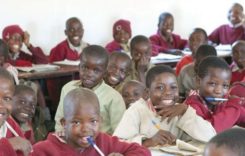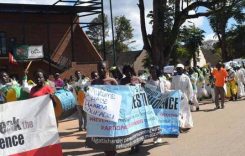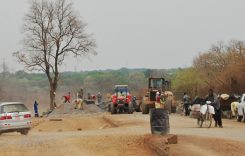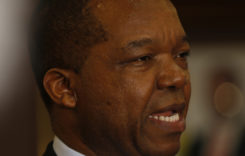Deforestation is about the greatest driver of climate change in the world and developing countries in sub-Saharan Africa and Asia are the major culprits.
By Nevanji Madanhire
The fight against deforestation goes to the core of the effort to curb climate change but methods used to educate communities on the scourge have not borne the desired results because they have often been too abstract for the bottom of the pyramid communities with little formal education.
Deforestation in Zimbabwe’s rural areas has continued unabated for the past 50 years accelerating terribly in the last 30. Many communal lands have turned into desert and this is despite efforts by various groups to educate people on the importance of preserving the country’s forests and generally managing the land in a sustainable manner.
According to the Forestry Commission of Zimbabwe (FCZ) forests in communal and resettled farming areas cover 10 million hectares and fall under the communal tenure. It is in these areas that Zimbabwe is losing most of its forests estimated to be at the rate of 300 000 hectares a year.
According to Country Energy Information Zimbabwe, in rural parts of the country, 80-90% of the people depend on wood fuel and kerosene for cooking and lighting.
Biomass accounts for about 66% of the energy use. Fuel wood is the most important domestic fuel in the country. It is the major source of energy for cooking, lighting and heating for over 80% of the population mainly in the rural and peri-urban areas.
Wood sources, particularly tree species that are traditionally used for firewood, have become scarce because of over-exploitation as firewood gets commercialized by those with the means to transport wood from distant areas.
The commercialization of firewood has become the major driver of deforestation and hence, climate change and has destroyed indigenous knowledge systems (IKS) used since time immemorial to preserve forests.
The over-reliance on firewood contributes to deforestation and respiratory diseases associated with indoor air pollution. In Zimbabwe, the effects of climate change as evidenced by the shift in seasons culminating in erratic rainfall patterns, has seen the country reeling from recurrent drought seasons resulting in food shortages and food hand-outs to stave off starvation among its population.
The most affected in this instance are the rural poor who rely heavily on firewood for energy thereby unwittingly contributing to deforestation and environmental degradation as they seek energy to sustain their livelihoods.
Climate change is defined as “the long-term shift from the normal climatic conditions, for example wind, rainfall quantity and humidity measured over a long period of time of between 30 and 35 years which is attributed to human activity or natural variability that alter the atmospheric composition.”
The fight against deforestation in Zimbabwe calls for a multipronged approach but the most important just might be through IKS but also, very importantly, through a mass shift to the use of renewable energy as the natural replacement of wood fuel.
What is IKS?
Underlying the failure to change attitudes toward forests has been the disconnect between rural folks’ traditional beliefs and methods used from time immemorial to preserve nature, on the one hand, and the education methods used by governmental and non-governmental organizations to teach conservation to the rural population, on the other.
Indigenous populations have difficulty linking deforestation to climate change. Methods used to explain this phenomenon have OFTEN been abstract.
The people of sub-Saharan Africa have always had a spiritual connection with nature. Their god is the god of nature. They have lived in the open savanna and in rainforests from where they have harvested food, medicine and everything else that has made them survive in nature.
For example, there was almost always a myth around the most important trees in the forest; there were trees which could not be cut for firewood, there were trees used for religious purposes and trees used exclusively for certain domestic purposes and yet others for medicinal purposes.
Many species of trees were closely linked with the religious beliefs and rituals of the communities which they still observe; often these beliefs were further linked with the existence of certain sacred animals. In an increasingly technological world these stories sound like old-wives tales but they still resonate with communal people.
Their belief systems therefore ensured that they evolved an ecological wisdom which stipulated that human societies must operate with the understanding that they are part of nature, not separate from it and they must maintain an ecological balance and live within the ecological and resource limits of their communities and planet.
IKS created a sustainable society which utilized resources in such a way the future generations would benefit and not suffer from the practices of the present generation. IKS sought to promote agricultural practices that replenished the soil through such methods as crop rotation that saw some farmland lie fallow for a while.
They lived in ways that respected the integrity of natural systems.
One-size-fits-all
The greatest threat to the ecological system is obviously deforestation resulting from a growing population clearing more and more land for agriculture or cutting down trees for domestic use.
Many non-governmental organizations have visited these people and attempted to teach them such complex subjects as global warming or climate change using the same methods they would use explaining the same concepts to university students.
But this one-size-fits-all approach has not been successful simply because, for rural communities, the method is too complex. How does one teach people about the depleting ozone layer when their conceptualization of the atmosphere is restricted only to “the air we breathe”?
The only method that may work should begin from what these people know. A bank of indigenous knowledge systems regarding the environment should be compiled with the help of the communities.
A good beginning, when dealing with deforestation for example, would be simply listing the names of trees found in a particular area. The second step would be allowing the villagers to explain the meanings of the names of trees and plants which have hidden knowledge in them.
The nomenclature will reveal the importance of each tree in the ecosystem.
Fig Tree
A good example of how such knowledge could be collected and documented would the fig tree.
Its latex is widely applied on warts, skin ulcers and sores, and taken as a purgative and vermifuge.
A decoction of the fruits is gargled to relieve sore throat; figs boiled in milk are repeatedly packed against swollen gums; the fruits are much used as poultices on tumors and other abnormal growths.
The leaf decoction is taken as a remedy for diabetes and calcifications in the kidneys and liver.
Fresh and dried figs have long been appreciated for their laxative action.
The tree indicates the presence of underground water.
Such knowledge will show the communities why it’s in their interest to preserve the fig tree. The rural communities have a wealth of such information on trees and plants in their forests.
If this body of knowledge is collected and disseminated in schools in the communal lands and in peri-urban communities, a basis for a solid preservation strategy of the country’s forests would be laid.
The long-term strategy would be to repackage the information gathered into documentaries that would be used in schools and on national television. Indeed the digitalisation of Zimbabwean television has opened vast opportunities for content production.
Renewable energy
Threats and issues on deforestation stem from national problems of energy poverty, population pressure and uncoordinated sectoral developments. Forest conservation cannot be fully achieved without addressing these issues.
Calls for the use of alternative sources of energy have been getting louder and louder by the year with the United Nations designating 2014–2024 as the decade of ‘Sustainable Energy for All’.
Former UN secretary-general Ban Ki-Moon said in 2011: “We need a global clean energy revolution – a revolution that makes energy available and affordable for all. This is essential for minimizing climate risks, for reducing poverty and improving global health, for empowering women and meeting the MDGs, for global economic growth, peace.”
But halfway through that period the energy deficit is still as wide as it was hence the increasingly louder call for the migration of marginalized communities to renewable energy.
Renewable energy refers to energy that comes from sources that are continuously replenished by nature – the sun, the wind, water, plants and the earth’s heat. Renewable energy technologies turn these into usable forms of energy such as electricity, heat and mechanical power. The major types of renewable energy sources are:
a) Biomass which includes:
Wood and wood waste
Municipal solid waste
Landfill gas and biogas
Ethanol
Biodiesel
b) Hydropower
c) Geothermal
d) Wind
e) Solar
In the communal farms, peri-urban areas and on farms for example, biogas can be the solution.
Many rural communities around Zimbabwe have adopted biomass digesters, a simple technology to produce biogas.
Biogas is an energy product derived from organic material such as animal dung, wood and grass that is decomposed in the absence of oxygen, thereby making a mixture that is mainly made up of methane gas. The gas can be used directly for cooking and lighting or for generating electricity.
This simple technology can be made compulsory in all households affected by energy poverty.
But to educate the rural masses on climate change and renewable energy there has to be a language for it. A good start would be to find local equivalents for the commonest technical terms.
Some useful technical terms
The following is a list of words that are mostly used in energy and environment and their simplified meanings to enable effective communication by stakeholders:
Anthropogenic: An effect caused or resulting from human activity.
Atmosphere: It is a layer of gases surrounding the earth and it is retained by gravity. The main gases in the atmosphere are nitrogen and oxygen and this is where life exists.
Bagasse: Dry pulpy residue left after the extraction of juice from sugar cane
Biomass: Fuels that are derived from natural material things that once lived, for example wood, dried vegetables and crop residue.
Biogas: A combustible gas produced from the anaerobic breakdown (without the presence of oxygen, fermentation and decomposition) of any organic materials by bacteria such as cow dung, kitchen or agricultural waste whose composition is mainly methane (60%) and carbon dioxide (40%).
Biogas digester: is a specially designed plant in which biogas production takes place in airtight conditions. A typical biogas digester is usually constructed using bricks and cement depending on the technology type. The digester is fed at least daily with the required quantity of organic material.
Chemical Energy: Chemical Energy is energy stored in the bonds of chemical compounds (atoms and molecules). It is released in a chemical reaction, often producing heat as a by-product (exothermic reaction). Batteries, biomass, petroleum, natural gas, and coal are examples of stored chemical energy.
Climate Change: A change in the known average climate conditions which is attributed directly or indirectly to human activity that alters the composition of the global atmosphere which is in addition to the natural variability observed over comparable time periods.
Climate change mitigation: An anthropogenic intervention to reduce the source or enhance the sinks of carbon dioxide.
Climate change adaptation: An adjustment in natural or human system in response to climate change which moderates harm or exploits opportunities. There are several ways which include prevention, tolerance, sharing losses, change in activity and restoration.
Community participation: Process whereby a community is encouraged to take part in decision-making and implementation of development programmes in which it is a beneficiary.
Coping strategy: Generally short term actions to ward off immediate risk, rather than adjusting to continuous or permanent threats or change. Coping can undermine the possibility of long term sustainable adaptation.
Degradation: Deterioration of the environment through depletion of resources such as water or soil.
Drought: Condition in which an area does not get enough water due to low rainfall, high temperatures, or both.
Ecosystem: All the living organisms and the physical environment in an area as well as the processes that link them together.
Ecological value: A measure of the significance of an area of land as a habitat supporting trees, plants and animals.
Flood: An overflow or influx of water beyond its normal confines
Food Security: Availability of food when needed, through production, storage or import.
Fossil Fuels: are sources of energy that have developed within the earth over millions of years. Because fossil fuels – oil, natural gas, and coal – take so long to form, they are considered non-renewable.
Gender: Differences between women and men that are socially constructed, changeable over time, and have wide variations within and between cultures.
Geothermal Energy: Geothermal energy is energy derived from the heat of the earth. The earth’s centre is a distance of approximately 6400 km and is so hot that it is molten. Temperatures are understood to be at least 5000 degrees centigrade.
Global Cooling: Global cooling was a conjecture during the 1970s of imminent cooling of the Earth’s surface and atmosphere culminating in a period of extensive glaciation.
Global Warming: The gradual rise in the earth’s average atmospheric temperature generally attributed to the effect of greenhouse gases such as carbon dioxide.
Greenhouse Effect: The presence of greenhouse gases in the atmosphere allow incoming sun rays to pass through to the earth’s surface but trap and absorb heat radiated by the earth surface resulting in elevation of the average surface temperatures. The effect makes the earth surface warmer in the same manner as a greenhouse keeps its inside temperature warmer.
Greenhouse Gases: Gases from the atmosphere that absorb and remit infrared radiation. These can be natural or anthropogenic (carbon dioxide, methane, nitrous oxide, sulphur hexafluoride, hydro fluorocarbons and nitrogen oxide.)
Grid: An integrated generation, transmission, and distribution system serving numerous customers. Characteristically, a grid is a portfolio of generating units operating under the control of a central dispatch center. Grids may be national, regional or local (in the latter case they are typically referred to as “mini-grids”).
Hydro Energy: Hydro energy is a renewable source of energy which uses the force or energy of moving water to generate power. This power or “hydroelectricity” is generated when falling water is channelled through water turbines.
Kinetic Energy: Kinetic energy is the energy of motion.
Non-renewable Energy: Energy that is not self-replacing and comes from fossil fuels.
Nuclear Energy: Nuclear energy is the energy released during nuclear fission or fusion, especially when used to generate electricity.
On-grid and off-grid: How electricity is delivered. Technically, every one of the commercial renewable resources can be and have been installed both on-grid and off-grid. Although larger megawatt installations tend to be on-grid, large renewable plants may profitably be built “inside the fence” – a term describing a self-generator, a plant built to supply a single customer such as a mine, a manufacturing plant or an agribusiness.
Off-grid: Serve only one load, such as a home or small business. Off-grid applications can take many forms, from photovoltaics for an individual village home to centralised windmills to power a village water pump or a commercial battery charging facility. Most generally used in remote or rural settings
Photovoltaic: Relating to the production of electric current at the junction of two substances exposed to light.
Pollution: Poisoning of land, air or water with anything that reduces its ability to support life.
Potential Energy: Potential Energy is the energy possessed by a body by virtue of its position relative to others, stresses within itself, electric charge and other factors.
Rainfall variability: Pattern of rainfall in arid environments where the amount and location of rain differ widely from year to year.
Renewable Energy: Energy obtained from sources that are essentially inexhaustible (unlike, for example fossil fuels of which there is a finite supply). Renewable sources of energy include conventional hydroelectric power, wood, waste, geothermal, wind, photo-voltaics and solar thermal energy.
Conclusion
Investing in renewable energy technologies is a promising option for combining the multiple goals of climate change mitigation, a low-carbon economy, employment creation (especially among the youth, thereby taking advantage of the growing number of young people out of work), energy security and sustainable development.
Do you want to use our content? Click Here












